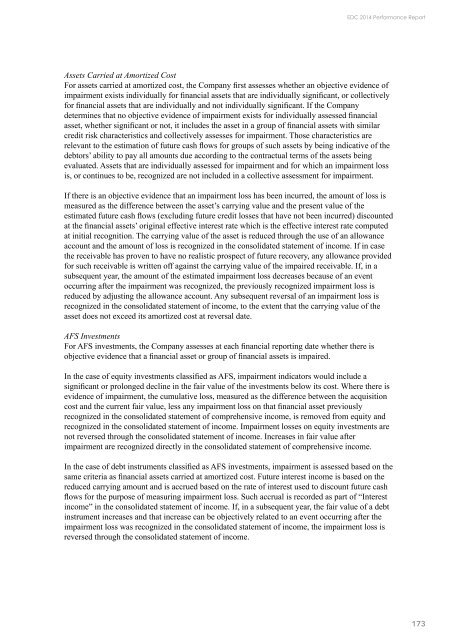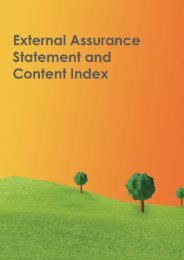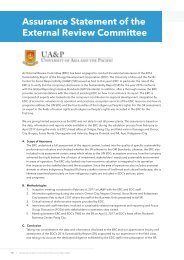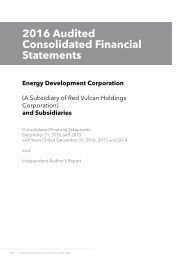EDC 2014 SR (UPDATED)
Create successful ePaper yourself
Turn your PDF publications into a flip-book with our unique Google optimized e-Paper software.
<strong>EDC</strong> <strong>2014</strong> Performance Report<br />
Assets Carried at Amortized Cost<br />
For assets carried at amortized cost, the Company first assesses whether an objective evidence of<br />
impairment exists individually for financial assets that are individually significant, or collectively<br />
for financial assets that are individually and not individually significant. If the Company<br />
determines that no objective evidence of impairment exists for individually assessed financial<br />
asset, whether significant or not, it includes the asset in a group of financial assets with similar<br />
credit risk characteristics and collectively assesses for impairment. Those characteristics are<br />
relevant to the estimation of future cash flows for groups of such assets by being indicative of the<br />
debtors’ ability to pay all amounts due according to the contractual terms of the assets being<br />
evaluated. Assets that are individually assessed for impairment and for which an impairment loss<br />
is, or continues to be, recognized are not included in a collective assessment for impairment.<br />
If there is an objective evidence that an impairment loss has been incurred, the amount of loss is<br />
measured as the difference between the asset’s carrying value and the present value of the<br />
estimated future cash flows (excluding future credit losses that have not been incurred) discounted<br />
at the financial assets’ original effective interest rate which is the effective interest rate computed<br />
at initial recognition. The carrying value of the asset is reduced through the use of an allowance<br />
account and the amount of loss is recognized in the consolidated statement of income. If in case<br />
the receivable has proven to have no realistic prospect of future recovery, any allowance provided<br />
for such receivable is written off against the carrying value of the impaired receivable. If, in a<br />
subsequent year, the amount of the estimated impairment loss decreases because of an event<br />
occurring after the impairment was recognized, the previously recognized impairment loss is<br />
reduced by adjusting the allowance account. Any subsequent reversal of an impairment loss is<br />
recognized in the consolidated statement of income, to the extent that the carrying value of the<br />
asset does not exceed its amortized cost at reversal date.<br />
AFS Investments<br />
For AFS investments, the Company assesses at each financial reporting date whether there is<br />
objective evidence that a financial asset or group of financial assets is impaired.<br />
In the case of equity investments classified as AFS, impairment indicators would include a<br />
significant or prolonged decline in the fair value of the investments below its cost. Where there is<br />
evidence of impairment, the cumulative loss, measured as the difference between the acquisition<br />
cost and the current fair value, less any impairment loss on that financial asset previously<br />
recognized in the consolidated statement of comprehensive income, is removed from equity and<br />
recognized in the consolidated statement of income. Impairment losses on equity investments are<br />
not reversed through the consolidated statement of income. Increases in fair value after<br />
impairment are recognized directly in the consolidated statement of comprehensive income.<br />
In the case of debt instruments classified as AFS investments, impairment is assessed based on the<br />
same criteria as financial assets carried at amortized cost. Future interest income is based on the<br />
reduced carrying amount and is accrued based on the rate of interest used to discount future cash<br />
flows for the purpose of measuring impairment loss. Such accrual is recorded as part of “Interest<br />
income” in the consolidated statement of income. If, in a subsequent year, the fair value of a debt<br />
instrument increases and that increase can be objectively related to an event occurring after the<br />
impairment loss was recognized in the consolidated statement of income, the impairment loss is<br />
reversed through the consolidated statement of income.<br />
173
















